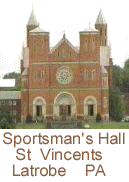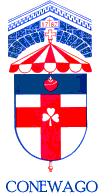
Few Catholics were part of the early immigration but our ancestors were present in the formative years of the Catholic Church in Pennsylvania. The first Catholic Chapel in Pennsylvania was established in Philadelphia in 1733 by Father Greaton. A count of Catholics in the colony, made in 1757 during the French and Indian War, shows only 1575 Catholics under the care of Father Robert Hardin in Philadelphia, Father Theodore Schneider at Goshenhoppen, Father Farmer at Lancaster, and Father Matthew Manners in York County, presumably at Conewago. In 1757, the total population of the Colony was about 120,000 so the colony was just 1 percent Catholic. We might note here that some of our ancestors were among the earliest Catholics to arrive. John Kuhn arrived in 1742 and Philip Cyphert, and Andrew Gret came in 1747. Also, Henry Reinsel was born about 1760.
Anti-Catholic sentiments were the normal thing in the colonies. Repressive religious laws were passed in all colonies except Pennsylvania and Maryland. During the French and Indian War, which ended in 1763, the Catholics were under suspicion for siding with the French. After that war, a relaxation of the official English anti-Catholic position occurred, but it was not until after the Revolution that Catholics were really free to practice their faith without official disapproval. It was not until 1790 that John Carroll was consecrated as the first Bishop of the United States with the entire country as his Diocese. In 1808, the Diocese of Philadelphia was formed with Michael Eagan as Bishop.
 The
old colonial Conewago Chapel at Edge Wood near Hanover, Pennsylvania is
now the Basilica of the Sacred Heart of Jesus. The Jesuits from
Maryland
were the First to minister to the people of this area. The first
settlers
moved into this area because it was at the intersection of two
important
trails; one originating in Baltimore and leading to Carlisle and the
north;
the other starting in Philadelphia and leading westward and southward
to
and beyond the Potomac river. The area was in the disputed territory of
Maryland and Pennsylvania and afforded a natural sanctuary for English
and Irish Catholics who were being persecuted for their religious
beliefs
in Maryland. The first priest, who's name we know, to visit the area
was
father Joseph Greaton, S.J. He arrived in Maryland in 1719 and was
assigned
a large mission area in Maryland and Pennsylvania. Some time before
1733
he took up residence in Philadelphia where he built St Josph's Church
in
Willing's Alley.
The
old colonial Conewago Chapel at Edge Wood near Hanover, Pennsylvania is
now the Basilica of the Sacred Heart of Jesus. The Jesuits from
Maryland
were the First to minister to the people of this area. The first
settlers
moved into this area because it was at the intersection of two
important
trails; one originating in Baltimore and leading to Carlisle and the
north;
the other starting in Philadelphia and leading westward and southward
to
and beyond the Potomac river. The area was in the disputed territory of
Maryland and Pennsylvania and afforded a natural sanctuary for English
and Irish Catholics who were being persecuted for their religious
beliefs
in Maryland. The first priest, who's name we know, to visit the area
was
father Joseph Greaton, S.J. He arrived in Maryland in 1719 and was
assigned
a large mission area in Maryland and Pennsylvania. Some time before
1733
he took up residence in Philadelphia where he built St Josph's Church
in
Willing's Alley.
In 1741 Father William Wappeler, S.J built a log dwelling and chapel which was dedicated to St Mary of the Assumption, but it was commonly called Conewago Chapel. The Chapel was enlarged in 1768 and it became the headquarters of the Jesuit missionaries of the St Francis Regis mission circuit.
Father Dimitri Gallitzin was the son of a Russian Prince who was the envoy of Catherine the Great to the Hague. The young Prince on visiting the colonies decided to become a priest and was ordained by Bishop Caroll in Baltimore in 1795. He was assigned to Conewago and remained there until 1799 when he moved to Loretto. He remained at the Loretto mission for 41 years and became known as the Apostle of the Alleghenies.
The St. Paul Mission was founded by Father Theodore Schneider a Jesuit. Although not the first Catholic Mission in Pennsylvania, its registers are the oldest surviving in the thirteen original Colonies. A significant gap in Father Schneider s records occurs, beginning in the middle of 1747 and extending to 1758. Then only the list of marriages is resumed. This was the period of the French and Indian War with its hostile Indian incursions and massacres in Berks County.
Father Schneider, who served at Goshenhoppen, was born in Geinsheim in the Diocese of Spires in the Palatinate on April 7, 1703. He taught philosophy in the Jesuit School at Liege and then became Rector of the Jesuit School at Heidelberg. In 1738, he was elected Rector Magnificus of the University of Heidelberg. Father Schneider was specifically requested for the Pennsylvania Mission. However, the Jesuit Provincial at Liege was apparently reluctant to have him go. Father Schneider was released from the Upper Rhine Provence in 1741. In 1741, he and Father Wappeler arrived in Pennsylvania, with Father Wappeler being in charge of the mission in Conewago, and Father Schneider in charge at Goshenhoppen. Father Neale and Father Greaton were in Philadelphia. Father Schneider lived in John Kuhn's House at Goshenhoppen until he could establish his own home. John Kuhn built the first chapel "St. Paul's" at Goshenhoppen. John Kuhn and his wife Anna Barbara are my earliest known ancestors in the colonies. They are the parents of Eva Kuhn who married Philip Schmidt in John Kuhn's House in 1742.
In 1764, following the French and Indian war, Father John Baptist Ritter succeeded Father Schneider as pastor at Goshenhoppen and he remained until he died in 1787.
Father Peter Helbron succeeded Father Ritter in 1787 and remained there until 1791 when he was transferred to Holy Trinity in church in Philadelphia. In 1799 he was appointed to the care of the Catholics in western Pennsylvania with his residence at the old mission known as Sportsman's Hall. In Western Pennsylvania, Father Helbron was active from 1799 to 1816 over a wide territory including at least Westmoreland, Fayette, Washington, Greene, Allegheny, Butler, and Armstrong (which then included Clarion) counties. Father Helbron died in Carlisle, Pa. in 1815 or 1816. Father Helbron's record shows that he visited Buffalo Creek (Sugar Creek) in October 1803 and returned several times to baptize and marry the settlers.
Father DeVaux served Goshenhoppen from 1791 until April 1793. He apparently left the church and he was replaced by Father Paul Erntzen who served from April 1793 until May 1818.
The church at Sugar Creek was visited by Father Helbron in 1803 and apparently Fr. Phelan arrived to take over the responsibilities there in 1805.
Father G.F.X. O'BRIEN recorded entries at Latrobe until Dec. 17, 1817. Father Charles Bonaventure Maguire, of Dungannon, Ireland, Order of St. Francis, arrived in Latrobe Dec. 29, 1817. He was at St. Patrick's in 1820 and his mission included all of Northwestern Pa.
Father Terrance McGirr followed Father Maguire at Latrobe in 1820 through 1826 and it is known that he visited Red Bank (Crates) during this time. He visited the Volkerbacher settlement (Lucinda) in 1826.
Father Patrick O'Neill was the pastor of Sugar Creek in 1826, succeeding Father Charles Ferry. His mission territory extended as far north as Erie. The first mass at Fryburg was said in the Eisenman home by Father O'Neill in 1826.
The First Bishop of Pittsburgh, Michael O'Connor reported in his first Census, taken in 1843, that the mission at Donegal had 1300 souls: Murrinsville, 500 and, St. Patrick's formerly known as the Buffalo Creek mission 1000. In 1843, there were only 47 Churches in the Pittsburgh Diocese which covered all of western Pennsylvania. A map of the Pittsburgh Diocese, for 1843, shows that there were 47 Churches in Western Pennsylvania in that year, the year the Diocese was founded. Included among these were Huntington, Loretto(1799), Ebensburg, Summit, Sugar Creek (Buffalo Creek), Red Bank (Crates)(1828), Eisemanns (Fryburg), Marysville (St. Marys) and St. Vincents at Latrobe (1799).
From the Fryburg, Register we find that
Fr. Skopez's
Missions in 1851 embraced Clarion, Lucinda, Fryburg, Crown, Crates,
Brookville
and other stations in Venango County.